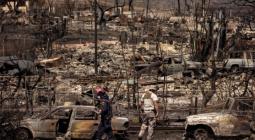Catalonia declares drought emergency, extending restrictions to Barcelona
Water reserves fall below 16% as region’s president says it has not rained in some areas for three years
fter more than 1,000 days of drought, the Catalan government has formally announced a state of emergency, extending water restrictions to Barcelona and the surrounding region.
Announcing the measures on Thursday, Pere Aragonès, the Catalan president, said that in some areas it had not rained at all for three years, describing the situation as the worst drought in modern history.
It is estimated that 500mm of rain needs to fall in Catalonia to make up the deficit. Water reserves have fallen below 16%, a level low enough to trigger the emergency declaration.
Measures already in place in the north of the region, including a 20% reduction in agricultural irrigation and a ban on watering public parks, will be extended to Barcelona.
Public and private swimming pools will close, with exemptions for those in sports centres, although some pools are adapting to use sea water. Parks will no longer be watered but groundwater will be used to save the city’s 35,000 trees from dying.
There will be no showers on the beach nor ornamental fountains. Water parks and ice rinks will close and car washing is to be limited to commercial use. The restrictions will remain in force for at least the next 15 months.
Plans to reduce water pressure have been shelved, partly because Barcelonans are keeping within a daily consumption limit of 200 litres and also because nearly everyone lives in blocks of flats and a pressure drop would discriminate against those living on upper floors.
The situation in Barcelona would be far worse were it not home to Europe’s largest desalination plant, built after the last serious drought in 2008, which supplies the city with 33% of its drinking water. A further 25% comes from recycled wastewater.
However, it costs three times as much to produce a litre of desalinated water through reverse osmosis as it does to take water from rivers and reservoirs.
It also consumes a lot of energy, not all of which as yet comes from renewable sources and therefore exacerbates the root problem by adding to global emissions.
As the Barcelona restrictions extend into summer, they are likely to fuel simmering resentment towards tourists, who are perceived as overwhelming public services, such as some bus routes, to the exclusion of local people.
Tourists consume much more water than residents. Research carried out by the hoteliers’ association showed that in 2016 a guest in a five-star hotel used 545 litres of water a day, compared with residents’ consumption of 163 litres. The association claims tourist consumption has since been reduced to 242 litres.
The drought is not confined to the north-east of Spain. In Andalucía, in southern Spain, two successive hot, dry summers have devastated the olive harvest, reducing production by 50% and doubling the price of olive oil. The grape harvest has also been poor in much of the country as even vines struggle to survive.
Tourist industry bosses say that while it’s easy to point the finger at golf courses and swimming pools, 80% of Spain’s water is consumed by agriculture.
Long before the climate crisis entered the equation, Spain was living beyond its means in terms of water, damming and diverting its few major rivers to irrigate the market gardens in the southern desert regions of Almería and Murcia.
While agriculture accounts for only about 2.3% of GDP and employs only 4% of the workforce, it punches above its weight in politics, as became clear when the government tried to restrict water use on the vast strawberry farms in the south-west.
Spain has always had periods of drought but climatologists largely agree that the droughts are getting longer while rainfall diminishes and temperatures continue to rise.
Cover photo: The Sau reservoir, in the province of Barcelona, is at its historical minimum, at 5.1% of capacity. Photograph: Adri Salido/Getty Images




